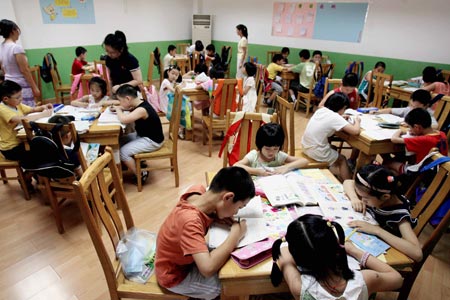In 2006, China's education sector achieved the objectives set for the first year of the 11th Five-Year Plan period (2006-10). The post-graduate education enrollment was 1.1 million, with 400,000 new students and 260,000 graduates. The general tertiary education enrollment was 17.39 million, with 5.4 million new students and 3.77 million graduates. Vocational secondary schools at various types had 18.09 million enrolled students, including 7.41 million new entrants and 4.76 million graduates. Senior secondary schools had 25.15 million enrolled students, including 8.71 million new entrants and 7.27 million graduates. Students enrolled in junior secondary schools totaled 59.58 million, including 19.29 million new entrants and 20.72 million graduates. The country had a primary education enrollment of 107.12 million, with 17.29 million new entrants and 19.28 million graduates. There were 360,000 students in special education schools, with 50,000 new entrants. Kindergartens accommodated 22.64 million children.
 |
Chinese teens are under heavy burdens due to the tight curriculum and heavy homework. Pictured are children in Shanghai engaged in their homework.
Revised Compulsory Education Law Effective
The revised Compulsory Education Law, whose focus is on the promotion of fairness in and balanced development of education, took effect as of September 1, 2006.
Under the law, students are totally exempt from paying tuition fees when receiving compulsory education. A new funding mechanism has been established to ensure free education. It also further clarifies the public service nature of compulsory education, which should be carried out following unified standards and on an obligatory basis.
The new law stipulates various approaches to assure that every child of the schooling age has access to education.
It, for the first time, contains clauses on education for all-round development of the recipients.
The law further defines the responsibility of governments at all levels for implementing compulsory education, the development of education for all-round development of the recipients and the balanced development of compulsory education, providing a legal basis in this field.
Reforms of the Funding Mechanism for Rural Compulsory Education
Since 2006, the Chinese Government has included funds for rural compulsory education in public finance via the establishment of a guarantee mechanism for this purpose, marking a milestone in China's education history. To implement this policy, 361 million yuan were allocated by financial budgets at all levels to grant subsidies, renovate schoolhouses and provide free textbooks and boarding for students.
In the spring semester of 2006, more than 48 million students in west China were granted exemption from tuition fees. Additionally, the Central Government earmarked special funds to assist 35.3 million students from poverty-stricken families in central and western areas for the purchase of textbooks. Local budgets also offered 6.8 million boarders living allowances. Every primary and junior secondary school in these areas benefited from this policy with compulsory education investment in most provinces increasing remarkably compared to the pre-reform level. Until autumn 2006, the exemption of tuition fees had been extended to the whole nation.
Also in 2006, central and local governments invested a total of 8 billion yuan in purchasing 350,000 sets of disc players, 190,000 satellite reception systems and 35,000 computer-aided teaching systems and related multimedia equipment. Multimedia teaching methods have been adopted by more than 80 percent of rural primary and junior secondary schools in central and west China. Efforts were also made to improve the quality of teaching staff in rural areas.
The overall implementation of the funding guarantee mechanism, dedicated to offering rural children free compulsory education, substantially eases financial burden on these students. Initial statistics show that some 200,000 dropouts in west China have returned to schools to continue their studies. The proportion of primary school graduates entering higher schools increased to 100 percent in 2006 from 98.4 percent in the previous year, making another record in China's education history.
Progress in Admissions Under Compulsory Education
In 2006, new entrants in primary schools began to rise, reversing the slide of past years. The total number reached 17.2936 million, an increase of 576,100 or 3.45 percent over the previous year.
The major increase came from rural areas. A total of 14.6108 million new entrants were reported in rural China in the year, an increase of 667,100 or 4.78 percent compared to 2005. Additionally, 23 provinces saw more rural students entering primary schools. Among them, Hebei, Henan, Hunan, Fujian, Shandong and Sichuan provinces each saw an increase of more than 60,000, jointly accounting for almost 70 percent of the total increase in rural areas. Primary schools in Hebei, Fujian and Hunan provinces also each registered a year-on-year increase of more than 10 percent.
In 2006, the net primary school enrollment rate for girls hit 99.29 percent, 0.04 percentage points higher than that for boys, making yet another record in history.
Junior secondary schools (including vocational schools) enrolled 19.2956 million students in 2006, a decline of 580,200. However, it still outnumbered the graduates from primary schools. These figures can largely be attributed to the policy of free compulsory education and living allowances for boarders, which encouraged more poverty-stricken children in rural areas to go back to school.
Development of Private Education
At the end of 2006, China's private universities (including colleges) numbered 596, 49 more than that in 2005, up 9 percent. Of the total were 318 colleges, an increase of 23 or 7.8 percent.
In the same year, new entrants to private higher education (including programs for adults and undergraduate and junior college courses) came to 1.03 million, up 17.1 percent year on year. In provinces and autonomous regions including Inner Mongolia, Jiangxi, Guangdong, Guangxi, Hainan and Yunnan, the growth rate surpassed 40 percent. Last year, private education accounted for 14.2 percent of China's higher education enrollment, 1.6 percentage points higher than the 12.6 percent of 2005.
The number of students in private higher education reached 2.805 million in 2006, up 31.9 percent year on year. In such provinces, autonomous regions and municipalities as Tianjin, Shanxi, Inner Mongolia, Jiangsu, Henan, Guangdong, Guangxi, Hainan and Qinghai, an increase of 50 percent or more was achieved. At present, private education accounts for 12.4 percent of the total students in China's higher education, up 10.6 percent, an increase of 1.8 percentage points over that in 2005.





